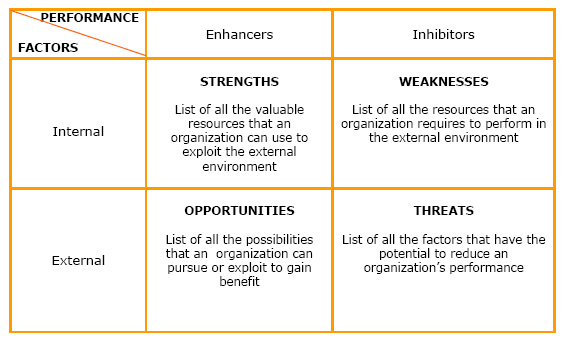Difference between revisions of "SWOT Analysis"
From Learning and training wiki
Chantal joly (Talk | contribs) |
Chantal joly (Talk | contribs) |
||
| Line 22: | Line 22: | ||
=='''Step by Step'''== | =='''Step by Step'''== | ||
*A brainstorming session is conducted to get inputs about the stengths of the organization. | *A brainstorming session is conducted to get inputs about the stengths of the organization. | ||
| − | *The facilitator | + | *The facilitator distributes paper cards and asks participants to write what are the things that they consider as strengths within the organization. Everyone is allowed to write as many things as they want. |
| − | *The facilitator then collects all the paper cards and | + | *The facilitator then collects all the paper cards and places them on a board. Inputs that are redundant are discharged |
*The same procedure is repeated for weaknesses, opportunities and threats. | *The same procedure is repeated for weaknesses, opportunities and threats. | ||
*Categorize all the SWOT factors into the [[#Job Aids|Matrix]] and work to build consensus around their placement. | *Categorize all the SWOT factors into the [[#Job Aids|Matrix]] and work to build consensus around their placement. | ||
Revision as of 14:21, 15 October 2008
| A tool that identifies the Strengths, Weaknesses, Opportunities and Threats of an organization. Specifically, SWOT is a basic, straightforward model that assesses what an organization can and cannot do as well as its potential opportunities and threats. The SWOT analysis takes the information from an environmental analysis and separate it into internal (strengths and weaknesses) and external issues (opportunities and threats). Once this is completed, the SWOT analysis determines what can be of assistance to the organization in accomplishing its objectives, and what obstacles must be minimized to achieve desired results. [1] |
|
To conduct a SWOT analysis identify the following four categories of the SWOT Matrix:
Strengths and Opportunities are identified as enhancers to desired performance, while Weaknesses and Threats are inhibitors.[2]
SWOT Matrix
Step by Step
Job Aids
|
References
- ↑ www.answers.com (20 August 2008), www.netmba.com (20 August 2008), en.wikipedia.org (20 August 2008)
- ↑ www.businessballs.com (3 October 2008), web.worldbank.org
- ↑ www.quickmba.com (13 August 2008), Wikipedia (13 August 2008), Project Cycle Management Guidelines, European Commission, 2004
